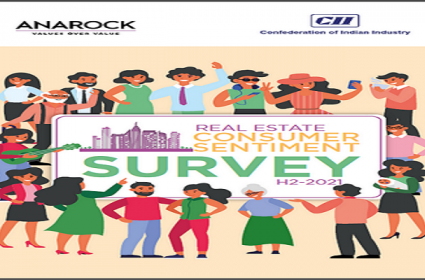56% Participants in CII-ANAROCK Survey Expect Housing Prices Hike in 2022, Affordable Housing Demand Sinks Further

A price rise of 10% will have a moderate-to-low impact on sales; a price rise of > 10% would have a high impact.
Newly launched properties are gaining traction in MMR & Bengaluru with over 31% of respondents favouring this category.
Residential plots are the 2nd best property type in the top 7 cities and the most preferred option in tier 2 and 3 cities.
Demand for an additional 1/2 BHK rises post-pandemic; 28% of respondents prefer this option in the face of WFH and e-schooling compulsions.
43% of respondents plan to buy in the city outskirts, while 63% prefer mid- and premium-segment options priced between INR 45 lakh and INR 1.5 Cr.
56% of respondents in the CII-ANAROCK survey expect housing prices to rise in 2022, while demand for affordable housing falls further.
Mumbai, February 18, 2022: 56% of respondents of the CII-ANAROCK Consumer Survey – H2 2021 expect housing prices to rise in 2022 due to inflationary trends in construction raw materials and overall operational costs for developers. The survey, conducted between July and December 2021, polled 5,210 participants via various digital platforms across tier 1, tier 2, and tier 3 cities.
In a quantitative analysis of the likely consumer reaction to such a price rise, the survey finds that an under-10% increase would have a moderate-to-low impact. However, an increase of over 10% would have more profound repercussions on buyer sentiment.
The survey also identifies an increasing demand for newly launched properties in cities like MMR and Bengaluru. Though ready-to-move-in (RTM) homes are still the most preferred category for 32% of respondents, this represents a 14% reduction in this preference since the first Covid-19 wave.
Over 31% of buyers in MMR and Bengaluru have a positive outlook on newly launched projects, possibly indicating a return of investors in these markets. Another major factor influencing this change is that post-Covid-19, the new housing supply is dominated by branded developers, which homebuyers perceive as safe.
Anuj Puri, Conference Chairman, 4th CII Real Estate Confluence & Chairman, ANAROCK Group, says, "Votes favouring real estate as an asset class rose by 3% in this survey – from 54% in the H1 2021 edition to 57% in H2 2021. This is especially significant since housing prices are likely to rise by 5–8% in 2022 due to increased input cost pressure and supply chain issues. Hardening interest rates, which are very likely in the second half of 2022, will be another factor driving up the overall acquisition cost for homebuyers. 56% of respondent homebuyers are aware of this. "
Nevertheless, the new pandemic-induced desire for homeownership continues to be robust, says Puri. At least 63% of previously fence-sitting respondents are now determined to become homeowners. For another 30%, the pandemic has not impacted their buying decisions, effectively resulting in 93% of respondents now being convinced of homebuyers. "
The survey also studies the property types in highest demand across cities, from preferred property sizes to the hottest-selling budget ranges and residential plots.
Residential plots are the second-most preferred property type in the top 7 cities and towns, and the most preferred option in tier 2 and tier 3 cities and towns. Apartments are still the property type of choice for urban buyers. Only 17% of surveyed urban buyers will pick a plotted development over other property types, but a significant 51% of respondents from tier 2 and tier 3 cities favour plotted developments. 21% of respondents in Chennai, 18% in Bengaluru, and 16% in Kolkata will buy plotted developments.
Extra living space continues to be a major ask amid ongoing and resilient WFH and e-schooling realities. 28% of respondents will buy homes with that extra half BHK—of which 72% had not considered this extra space essential before the COVID-19 pandemic.
Approx. 43% of respondents will buy homes in the city peripheries—just 22% now prefer to live within city limits, close to office hubs. The future of work is tilting towards the hybrid model, and proximity to offices is no longer a significant concern.
In terms of budget preferences, approximately 63% prefer homes in the mid and premium segments priced within INR 45 lakh–INR 1.5 Cr. The demand for affordable housing has dropped further, from 40% of the votes in the survey's H2 2020 edition to 27% in H1 2021 and 25% in H2 2021.
As always, the survey also provides updated insights on its respondents' investment timelines, horizons, and age brackets. In short, the CII-ANAROCK Consumer Survey – H2 2021 unwraps the latest housing demand trends and shows what developers must focus on to harness this demand.























